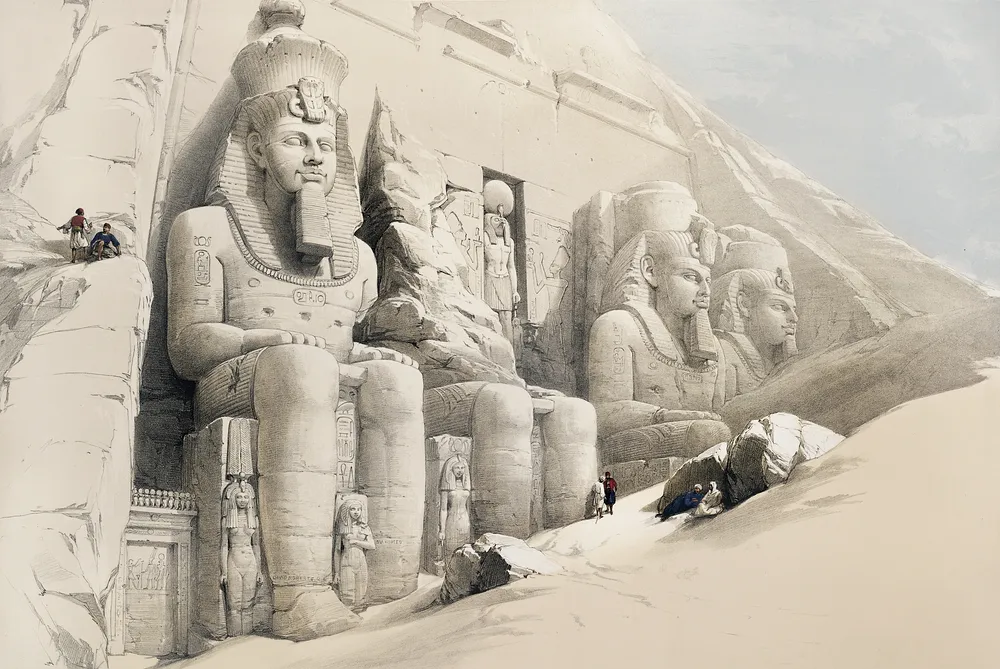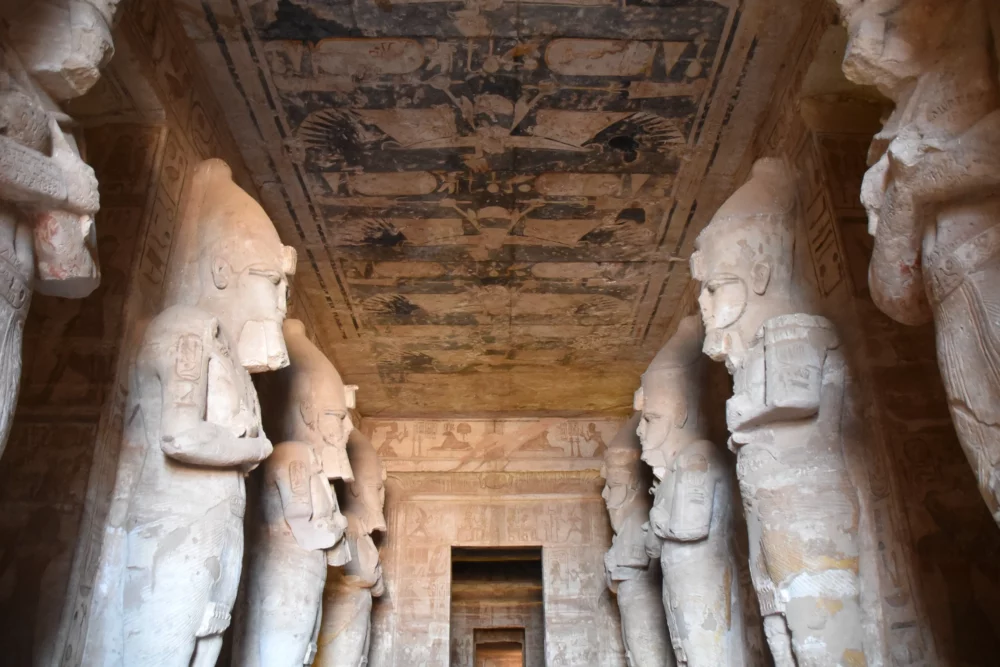
The glorious and magnificent ancient temple complex called Abu Simbel can be found in southern Egypt at the second cataract of the Nile River. It was originally carved out of a solid rock cliff. The two temples that make up the site were built either between 1264 and 1244 BCE or 1244 and 1224 BCE during the reign of Ramesses II (c. 1279 – c. 1213 BCE). Different scholars have different ideas about Ramesses II’s life, which is why the dates are different.

Top Ten Facts about Abu Simbel temples
- Abu Simbel is a complex of two temples located in southern Egypt, south of Aswan.
- The temples were built during the reign of Pharaoh Ramesses II in the 13th century BCE and were dedicated to him and his queen, Nefertari.
- The temples were carved into the rock face and feature intricate carvings and massive statues of pharaohs and gods.
- The larger temple at Abu Simbel is called the Great Temple and is 98 feet tall, while the smaller temple is called the Temple of Hathor and is dedicated to Ramesses’ wife, Nefertari.
- The temples were actually relocated in the 1960s to save them from being flooded by the rising waters of Lake Nasser, which was created by the construction of the Aswan High Dam.
- The relocation was an incredible engineering feat, involving cutting the temples into large blocks, moving them to higher ground, and reassembling them.
- The temples are aligned with the sun in such a way that twice a year, on the equinoxes, the rays of the sun penetrate deep into the inner sanctum of the Great Temple, illuminating the statue of Ramesses II.
- The temples were rediscovered in 1813 by Swiss explorer Johann Ludwig Burckhardt, and were later visited by other famous explorers including Gustave Flaubert and Jean-Francois Champollion.
- The temples at Abu Simbel are considered some of the most impressive and well-preserved examples of ancient Egyptian architecture and art.
- Abu Simbel is now a UNESCO World Heritage Site and attracts visitors from all over the world who come to marvel at its incredible beauty and historical significance.
The Structure and Interiors of Abu Simbel

It is certain that the buildings were created, at least in part, to commemorate Ramesses’ triumph over the Hittites in the Battle of Kadesh in 1274 BCE, based on the rich artwork uncovered throughout the Great Temple’s interior. According to some experts, the earliest building occurred about 1264 BCE, while the people were still celebrating their triumph. Others believe that the decision to erect the massive monument at that precise location, on the border with the conquered lands of Nubia, points to a later date of 1244 BCE because it would have needed to begin following the Nubian Campaigns undertaken by Ramesses II and his sons and erected as a symbol of Egypt’s power.
Regardless of the exact commencement date, it is widely accepted that the complex took twenty years to construct and that the temples honour the gods Ra-Horakty, Ptah, the deified Ramesses II (The Great Temple), the goddess Hathor, and Queen Nefertari, Ramesses’ favourite wife (The Small Temple). Despite common assumptions, the complex was not known as “Abu Simbel” in ancient times.
The two temples The Great Temple is 98 feet (30 metres) in height and 115 feet (35 metres) in length. Ramesses II is enthroned on his throne in two seated colossi on either side of the entryway, each measuring 65 feet (20 metres). These massive sculptures are flanked by smaller but still life-size statues of Ramesses’ vanquished adversaries, the Nubians, Libyans, and Hittites.
The Temple Story

More statues show members of his family as well as various gods and symbols of power. The interior of the temple is decorated with engravings showing Ramesses and Nefertari paying respect to the gods as you pass between the colossi through the main entrance. Along the north wall of the Hypostyle Hall, a detailed representation of Ramesses’ great victory at Kadesh can be seen. This victory is thought by contemporary scholars to be more of a draw than an Egyptian triumph. The scholars Oakes and Gahlin claim that these engravings of the battle’s prelude, Give a lively account in both text and reliefs.
In the Egyptian camp, battle preparations are underway. While one soldier gets his wounds dressed, the horses are harnessed or given their feed. Another scene shows a council of war between Ramesses and his officers, as well as the king’s tent. Two Hittite spies are apprehended and tortured until they divulge the real location of the Hittite king Muwatalli. When the battle finally breaks out, the Egyptians charge in orderly formation while the Hittites are in disarray, their chariots crashing, their horses bolting, and their soldiers falling into the River Orontes. Except for the assistance of [the god] Amun, who defends him in battle and ultimately grants him victory, Ramesses faces the entire Hittite army alone in the text (208). The Small Temple is a nearby structure that is 92 feet (28 metres) long and 40 feet (12 metres) tall.
Additionally, the front facade of this temple is adorned with three colossi on either side of the doorway that stand 32 feet tall and show Ramesses and his queen Nefertari (10 metres). The prominence of the queen is demonstrated by the fact that, in contrast to Abu Simbel, where Nefertari is portrayed as being the same size as Ramesses, women are typically depicted on a much smaller scale than pharaohs. The Small Temple is notable for being only the second time in the annals of ancient Egypt that a pharaoh dedicated a temple to his wife.
The first was Pharaoh Akhenaton, who did so for his queen Nefertiti in 1353–1336 BCE. Images of Ramesses and Nefertari making offerings to the gods as well as representations of the goddess Hathor adorn the walls of this temple. Sacred Place It is believed that Ramesses carefully selected the site because it was sacred to Hathor long before the temples were built there. Ramesses is regarded as a god among gods in both temples, and his selection of a place that was already revered by the populace would have accentuated this impression.
The Temple Orientation and the Sun Festival
The temples are also oriented toward the east, which means that on February 21 and October 21, respectively, the sun shines directly into The Great Temple’s sanctuary, illuminating the statues of Ramesses and Amun. It is known as the Sun Festival and attracts a massive amount of visitors during this time to watch this event. The times are believed to be Ramesses’ birth and coronation dates. The sanctuary of The Great Temple differs from these other sites in that the statue of the god Ptah, who stands among the others, is carefully positioned so that it is never illuminated at any time. The alignment of sacred structures with the rising or setting sun, or with the position of the sun at the solstices, was common throughout the ancient world.
Moving the Temples

The High Dam at Aswan The Egyptian government intended to construct the Aswan High Dam on the Nile in the 1960s CE, which would have submerged both temples (and also surrounding structures such as the Temple of Philae). Both temples were disassembled, moved 213 feet (65 metres) up onto the plateau of the cliffs they once sat below, and then rebuilt 690 feet (210 metres) to the northwest of their original location between 1964 and 1968 CE. At a cost of over 40 million US dollars, UNESCO spearheaded this project with a multi-national team of archaeologists. A man-made mountain was built to give the appearance that the temples were cut into the rock cliff, and great care was taken to position both temples in precisely the same direction as before. Oakes and Gahlin state the following: A coffer dam had to be constructed before construction could start in order to shield the temples from rising water.
The temples were then sawn into blocks, being careful to place the cuts where they would be hidden when assembled. A reinforced concrete supporting framework held up the interior walls and ceilings. The joints were filled with mortar made of cement and desert sand when the temples were put back together. Because it was done so covertly, it is now impossible to tell where the joins were made. Both temples are currently supported by two enormous reinforced concrete domes inside of an artificial mountain made of rock and debris. All of the smaller statues and stelae that surrounded the complex’s original site were also moved and put in the places where the temples should have been.
After the Pyramids of Giza, Abu Simbel is currently Egypt’s most popular ancient site, and it even has its own airport to accommodate the tens of thousands of visitors who come here each year. Holiday Tours, the primary travel agency in Egypt offers a wide variety of Abu Simbel tour packages from Aswan and Cairo. The tours are organized with pick-up and drop-off from the hotel or Airport. With highly knowledgeable tour guides and organized tours, you can avoid hassles and get the most out of your visit.



